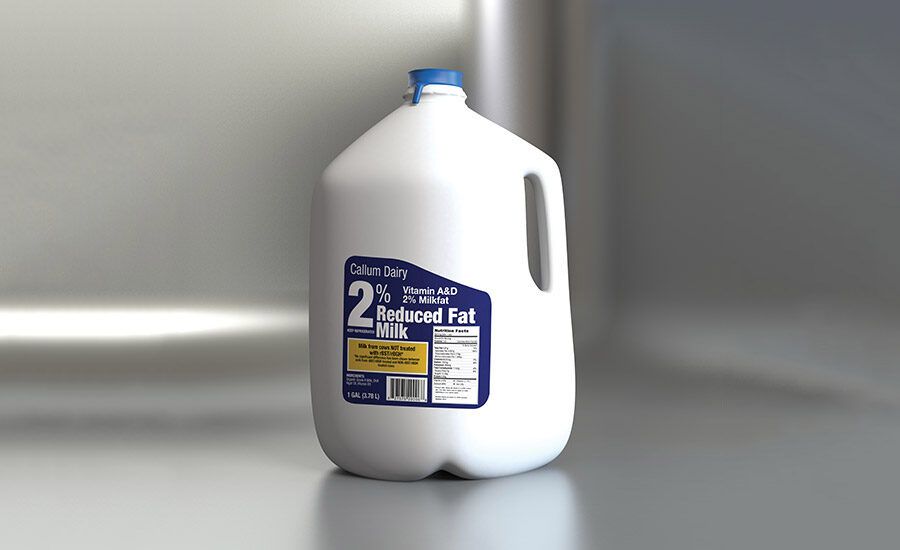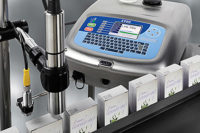4 questions to help improve labels, labeling performance
From sustainability demands and trends, to challenging processing environments, the choices manufacturers make with their labels can have a significant impact. Labeling suppliers discuss these topics and more.

Dairy jugs such as this have been successfully labeled in a cold, wet environment. It features a durable paper face stock that has extreme wick resistance, thus preventing the label from absorbing excess water and maintaining the label’s image and information, according to Avery Dennison.

New York-based siggi’s Icelandic-style yogurt is packaged in cups that utilize Greiner’s K3 technology. The cardboard-plastic combination packaging features a patented tear-open system that delivers the ability to easily separate its plastic and cardboard components, making it easy to recycle.


Question 1: What various types of materials are used for dairy labeling?
A fair amount of shrink sleeves are entering into beverage and dairy, according to Avery Dennison, Glendale, Calif. Shrink sleeve technology lends itself to customizing and seasonal promotions. Shrink sleeves can also be designed to cover caps, adding a measure of safety and tamper resistance.
Overnight Labels, Deer Park, N.Y., recommends the use of standard semi-gloss and high-gloss papers for many applications. Clear and white polypropylenes are used for a premium look. Additionally, shrink sleeves are a big part of what the company uses for dairy beverages. Hard-to-label items, like plastic milk jugs filled in a wet environment, use a special wet-strength material with a specific adhesive used for the application.
H.S. Crocker, Huntley, Ill., primarily uses foil and a nonfoil lidding material, said Ron Giordano, chairman and CEO of the company. “The nonfoil is not PET but is a paper/poly product that is good for cold or hot-fill products.”
Question 2: How do sustainability trends impact labeling choices?
According to Jörg Sabo, marketing director for Greiner Packaging, Pittston, Penn., packaging with ecological appearances are becoming more important. New labels made with cardboard can reduce the amount of plastic which has a positive impact on the CO2 emissions, while also being comfortable to hold and add a premium ecological look and feel.
“In regard to the dairy industry’s commitment to sustainability, labels can dovetail nicely,” said Avery Dennison’s Michael Leroy, Prime Paper products manager. “Avery Dennison’s Dairy Print portfolio offers papers certified by the Forest Stewardship Council. The portfolio is designed to meet the demand of converters and brand owners who seek more sustainable labeling solutions. These are price-neutral solutions to encourage the use of sustainable materials.”
Question 3: In general, milk jugs are filled in a cold wet environment. What steps can processors take to make sure labels adhere to the container?
“It’s all about the pressure-sensitive label material being used,” said Don Earl, president and owner of Overnight Labels. “It must be a wet-strength type material with an adhesive that will adhere to the container in that type of environment.”
According to Sabo, when using in-mold labeling as a label decoration, the main advantage is that shaping and decoration are done in one step.
“This means the labels are scratch-and humidity-resistant and are insoluble from the packaging,” he said. “For cardboard wrap technology, there are no issues in the production environment as the cardboard can be adhered with glue dots to the packaging. The glue dots will stick without issue and the humidity has no impact on the cardboard label.”
Leroy noted that “labels not only have to adhere to the container, but they also must maintain the label image through the challenges of this environment.” His company’s Dairy Print portfolio utilizes a durable paper facestock with extreme wick resistance that prevents the label from absorbing excess water and maintains the integrity of the image and information on the label.
“These labels are being applied to containers that are filled quickly, packed tight and moved through a shower,” said Leroy. “That means there’s not a lot of time for air circulation to allow the label to adhere over time. [Our] portfolio utilizes a hotmelt adhesive that provide a high tack for immediate adhesion, ensuring the label sticks during the product’s lifetime.”
Giordano said, “We would recommend [milk jug] bottles go through air dryers at low temps to blow off the moisture and then through a web wipe to insure the bottles were fairly clean.”
Question 4: How can the printing, color and recyclability of labels be improved?
Sabo said that printing on cardboard labels gives the best results with photo-realistic pictures. Six-color print in combination with aluminum lamination, embossing and hot stamping possibilities gives all the options needed to add a premium look to packaging. The separation of cardboard and plastic, such as the tear off strip on the outer cardboard wrap/label of Greiner’s K3 dairy cup, makes it easy to recycle both components.
Overnight Labels’ Earl suggested that “recyclability can be improved by using clean flake material that lifts off during the recycling process. Using a vendor that has both digital and flexographic printing can help reduce waste.”
Bonus Question!
What can dairy food manufacturers do to insure their labels stand out on the shelf?
Avery Dennison said shrink sleeves are the way to go. For the brand owner, sleeves offer flexibility in design and packaging. A 360-degree label allows the entire container to be used for artwork and information, adds shelf appeal and helps it to stand out for increased brand identity.
According to Jörg Sabo at Greiner Packaging, technologies such as cardboard wraps signify a completely new approach to food packaging. Cardboard labeling provides full-cup coverage and a wrap that can be printed with up to six colors on both sides, delivering full 360-degree design capability. To boost the premium look, companies can add different types of ink (such as metallic), embossing or window cut outs.
Dairy processors can maximize marketing opportunities by printing recipes or contests/raffles inside the cardboard wrap. Adding customer engagement opportunities are a significant added benefit for any brand helping them stand out, Sabo said.
“They should try to have their labels hot-stamped or embossed or use more premium materials,” said Don Earl from Overnight Labels. “The dairy industry should look at its neighbors in the other areas of the supermarket that are creating very nice designs for low-margin items. There are many food and vitamin labels that are printed on premium papers that are hot-stamped or are printed with beautiful graphics.”
Looking for a reprint of this article?
From high-res PDFs to custom plaques, order your copy today!











